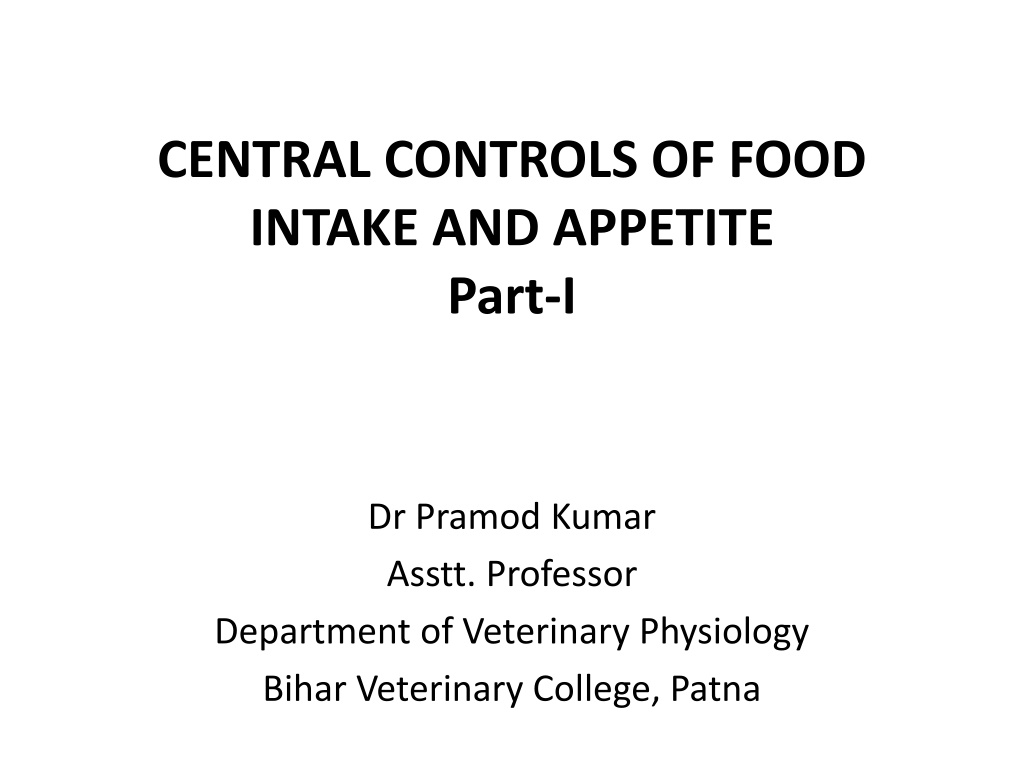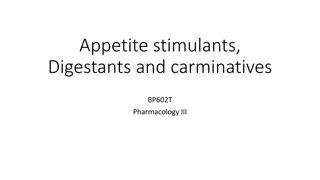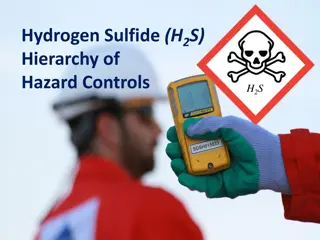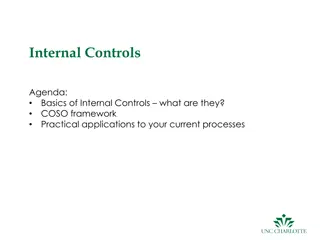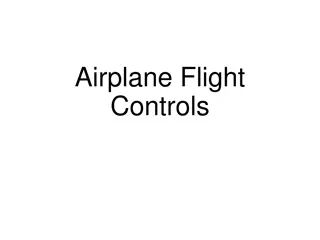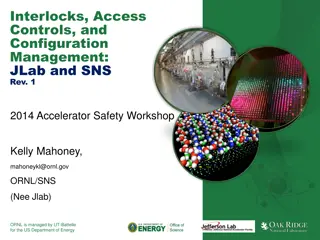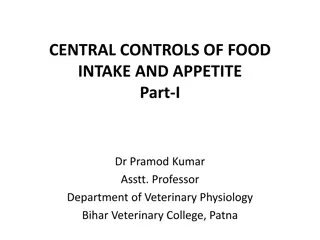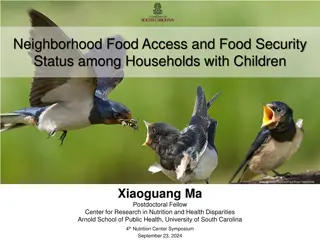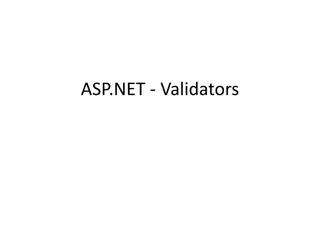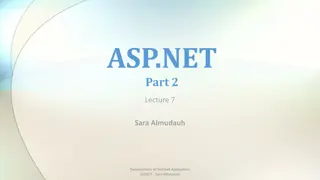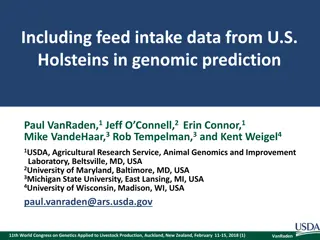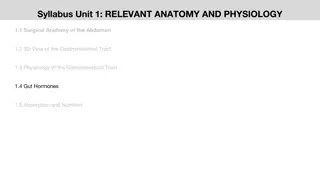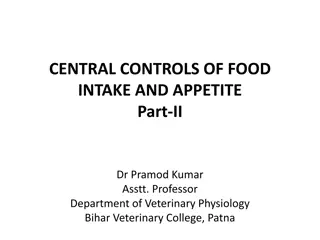Understanding Central Controls of Food Intake and Appetite Regulation
Exploring the intricate mechanisms behind food intake and appetite regulation, this informative content delves into the pivotal role of the brain regions such as the hypothalamus and brainstem. It discusses how peripheral signals, neural pathways, and neuropeptides collaborate in orchestrating hunger, satiety, and energy balance. By uncovering the functions of key hypothalamic nuclei and neuronal populations, this study sheds light on the physiological processes governing our food consumption.
Download Presentation

Please find below an Image/Link to download the presentation.
The content on the website is provided AS IS for your information and personal use only. It may not be sold, licensed, or shared on other websites without obtaining consent from the author. Download presentation by click this link. If you encounter any issues during the download, it is possible that the publisher has removed the file from their server.
E N D
Presentation Transcript
CENTRAL CONTROLS OF FOOD INTAKE AND APPETITE Part-I Dr Pramod Kumar Asstt. Professor Department of Veterinary Physiology Bihar Veterinary College, Patna
CENTRAL CONTROLS OF FOOD INTAKE AND APPETITE Coordination by the Hypothalamus Role of the Brainstem Neuropeptides Central Neurotransmitters Hedonic Mechanisms Mnemonic Representations of Experience with Food Endocannabinoids
Coordination by the Hypothalamus Hypothalamus - gate keeper in the control of food intake and appetite. Peripheral signals of energy balance may act directly on the hypothalamus to control food intake communication between the hypothalamus and higher cortical centers pertaining to food memory and rewarding aspects of food lateral hypothalamus hunger center, medial hypothalamus satiety center .
Role of the Brainstem sensing of energy balance and modulation of food intake dorsal vagal complex (DVC) is the main organ responsible for facilitating the communication between peripheral signals of food intake and hypothalamic nuclei DVC consists of : nucleus of the tractus solitarius (NTS), area postrema (AP) and dorsal vagal nucleus (DVN).
Vagal nerve afferents: carry sensory information relaying hunger and satiety from the gut directly to the NTS (increased meal size and duration) AP receive metabolic signals of energy balance (e.g., hormones and nutrients carried by the blood) directly (absence of complete BBB) Efferent pathways : hypothalamus DVN (modulates) efferent vagal nerve activity alter gastric emptying, gastric motility and pancreatic secretions.
Hypothalamic Nuclei Implicated in the Control of Food Intake Arcuate nucleus hypothalamic area which controls food intake and neurons within the ARC: 1- neurons contains neuropeptide Y (NPY) and Agouti related peptide (AgRP) activates to enhance food intake (orexigenic) 2- neurons containing pro-opiomelanocortin (POMC) and cocaine and amphetamine regulated transcript (CART) and activates to reduce food intake (anorexigenic) (ARC) is the main
Axons from ARC (NPY/AgRP and POMC/CART) neurons project to hypothalamus: Paraventricular nucleus hyperphagia and obesity in rats Ventromedial nucleus (VMN), dorsomedial nucleus (DMN), lateral hypothalamic area (LHA) and perifornical area (PFA) modulates food intake other areas of the (PVN) causes
Hormones of GI tract Neuropeptide Y is the most powerful central stimulant of appetite and approx. 90% of NPY neurons co-express AgRP Central administration of NPY enhances food intake repeated daily injections of NPY into the hypothalamus result in chronic hyperphagia and weight gain in these animals Ablation of NPY/AgRP neuron leads to reduce body weight via reduced food intake Y1 and Y5 receptors seem to mediate the orexigenic effect of NPY
Agouti-Related Peptide/AgRP competitive antagonist of anorexigenic central melanocortin receptors in the PVN and increases food intake action on orexin or opioid receptors Pro-opiomelanocortin and Melanocortins (POMC) precursor of melanocyte-stimulating hormone. MSH binding to the MC4R acts to reduce food intake homozygous mutations in the POMC gene in humans result in early- onset obesity Cocaine and Amphetamine Regulated Transcript is co- expressed by most POMC neurons in the ARC. Central intracerebroventricular administration of CART reduces food intake
Hypothalamic Releasing Hormones Corticotropin-releasing hormone and thyrotropin releasing hormone are expressed in PVN neurons. both inhibit food intake Orexins Orexin A and B activate G-protein coupled receptors to increase food intake. Melanin-Concentrating Hormone is an orexigenic signal expressed in neurons located in the LHA Infusion of MCH increases food intake and body weight Brain-Derived Neurotrophic Factor is highly expressed in the VMN and acts via MC4R signaling to reduce food intake
Serotonin produced in the dorsal raphe nucleus reduces food intake and body weight Norepinephrine produced in the DVC and locus coeruleus, has differing effects on 2receptors stimulates food intake, 1, 2, and 3receptors reduces food intake Dopamine inhibit food intake in the ARC and LHA have orexigenic action in the VMN to act on D1 and D2 receptors of dopamine which reduces food intake.
Hedonic mechanisms and cortico-limbic pathways control appetite and food intake - Visual, smell and taste signals can override satiety signals to maintain food intake These sensory signals are conveyed from NTS in the brainstem to cortico-limbic reward centers implicated in appetite regulation Dopamine, serotonin, opioids and nor-epinephrine have been implicated as important neurotransmitters involved in signaling within this network. Mnemonic representations of experience with food Past experience with specific foods forms an important contributor to continue consumption Orbito-frontal cortex (OFC), an area that receives converging sensory input in the non-homeostatic control of food intake.
Endocannabinoids shown to produce a dose dependent orexigenic effect and this effect is thought to occur via modulation of reward circuitry 1) Anandamide derived phospholipids 2) Arachidonoylglycerol (2-AG), derived from triglycerides Endocannabinoids may also act directly on the hypothalamus to exert their orexigenic effect. These substances are secreted by postsynaptic neurons and act in retrograde fashion. from membranous
